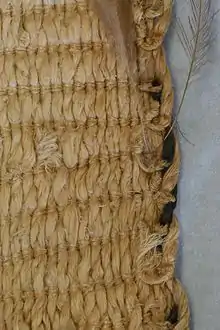Muka
Muka is prepared fibre of New Zealand flax (Māori: harakeke).[1] Prepared primarily by scraping, pounding and washing, it is a key material in Māori traditional textiles where it is usually used in tāniko or twined weaving.

In pre-European times, muka was widely used by the Māori and was the primary fibre used for weaving clothing. Patu muka or pounding stones were a distinct tool type.[2]
In the early colonial period, muka was a trade staple, often being traded for muskets with devastating effects.[3] Well into the European era it was used for paper, clothing and sacking, with large commercial workings Foxton and elsewhere.[4]
Since the Māori renaissance the resurgence in traditional Māori weaving has seen up-swing in the use of muka, especially for art and high-end craft items. Usually woven muka is distinguished from woven (unprepared) flax which is only suitable for coarse work such as bags (kete) and panels.
References
- "Māori Dictionary". maoridictionary.co.nz. 2011. Archived from the original on 25 April 2012. Retrieved 10 October 2011.
(noun) prepared flax fibre. He harakeke iraira, he mumura te kākāriki o ngā whā, he kōwhai ngā tāekaeka, he karaka ngā tapa me te tuaka, he mā, he mōhinuhinu te muka o tēnei harakeke (PK 2008:603). A variegated flax, with bright green leaves, yellow stripes, orange edges and midrib, while the fiber of this flax is white and shiny.
- "Patu muka - Collections Online - Museum of New Zealand Te Papa Tongarewa". collections.tepapa.govt.nz. 2011. Retrieved 10 October 2011.
- "The early flax trade - Flax and flax working — Te Ara". teara.govt.nz. 2011. Retrieved 10 October 2011.
The Māori producers were not paid in cash but in goods – usually muskets. The trade therefore had a lasting impact on Māori society. With firearms, conflicts between tribes turned into full-scale wars. Tribes competed for control of the flax trade and thus the supply of muskets.
- "Last flax cut, Foxton - Manawatū and Horowhenua places — Te Ara". teara.govt.nz. 2011. Retrieved 10 October 2011.
